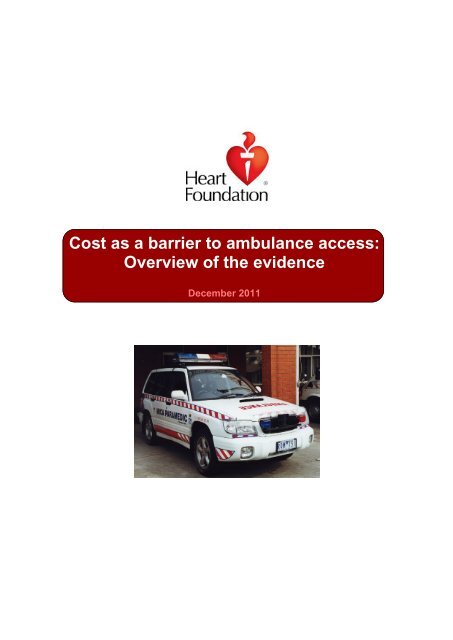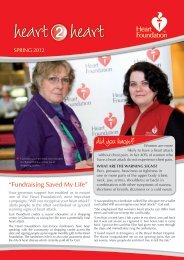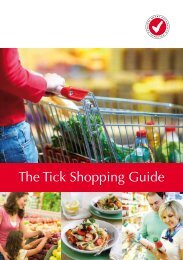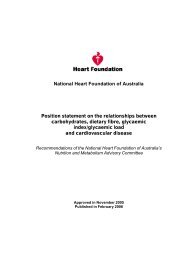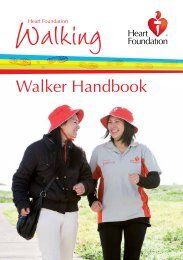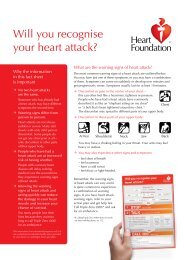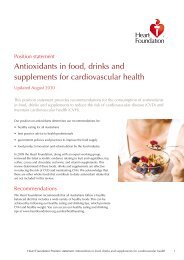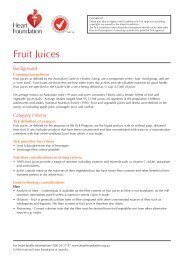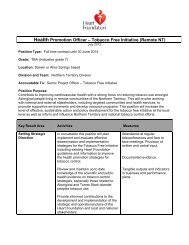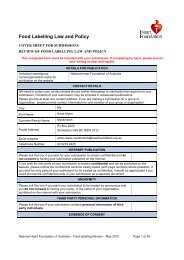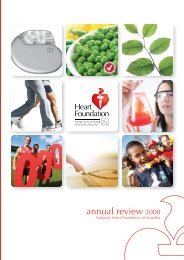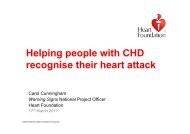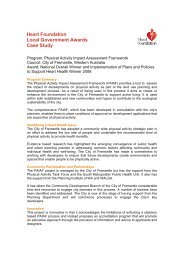Cost As A Barrier To Ambulance Access - National Heart Foundation
Cost As A Barrier To Ambulance Access - National Heart Foundation
Cost As A Barrier To Ambulance Access - National Heart Foundation
Create successful ePaper yourself
Turn your PDF publications into a flip-book with our unique Google optimized e-Paper software.
<strong>Cost</strong> as a barrier to ambulance access:<br />
Overview of the evidence<br />
December 2011
For further information regarding this report, contact:<br />
Christopher Poulter<br />
Policy Officer<br />
<strong>Heart</strong> <strong>Foundation</strong><br />
(03) 9090 2038<br />
christopher.poulter@heartfoundation.org.au<br />
2
Key Messages<br />
Those who are not covered for an ambulance or live within non-universal ambulance<br />
coverage states/territories, are significantly less likely to intend to call Triple Zero<br />
(000), if they thought they were having a heart attack.<br />
ACS patients who have not travelled to hospital by ambulance and who identify with<br />
being ‘worried about the cost of an ambulance,’ are significantly less likely to intend<br />
to call Triple Zero (000) the next time they experience similar symptoms.<br />
Universal ambulance coverage in the longer term, appears to:<br />
- Foster greater ambulance use in patients who need it most (i.e. urgent cases)<br />
- Not significantly increase ambulance use for non-urgent presentations to hospital<br />
Introduction<br />
E<br />
vidence demonstrates that travelling to hospital by<br />
ambulance is strongly associated with shorter prehospital<br />
delay times for suspected heart attack, thereby<br />
reducing time to definitive treatment. The ‘barriers’ to accessing<br />
an ambulance are both individual and systembased.<br />
Doubt, denial and embarrassment are well-known<br />
individual barriers which the <strong>Heart</strong> <strong>Foundation</strong> is addressing<br />
through the ‘Will you recognise your heart attack?’<br />
social marketing campaign. System barriers, such as cost<br />
of an ambulance, restrict access to ambulance services<br />
for some people.<br />
In May 2010, the <strong>Heart</strong> <strong>Foundation</strong> released a discussion paper, titled universal ambulance cover.<br />
The development and release of the discussion paper followed <strong>Heart</strong> <strong>Foundation</strong> research which<br />
showed 7% of people (nationally) would delay calling Triple Zero (000) for a suspected heart attack<br />
based purely on the cost of an ambulance. 1 A thorough stakeholder consultation process followed<br />
the discussion paper’s release. One of the key recommendations arising from the discussion paper<br />
consultation was to further explore the impact of cost on ambulance access. In response to this<br />
strong recommendation, the <strong>Heart</strong> <strong>Foundation</strong> has undertaken further analysis to better understand<br />
the extent to which cost is a barrier for some people accessing an ambulance for time-critical emergencies,<br />
such as heart attack. This report highlights new data analysis encompassing:<br />
Intention to call Triple Zero (000)<br />
Trends in ambulance use and demand<br />
Factors contributing to non-ambulance use for acute coronary syndrome (ACS) patients<br />
3<br />
1. <strong>Heart</strong> <strong>Foundation</strong>. Warning Signs baseline survey 2008
Intention to call Triple Zero (000)<br />
The <strong>Heart</strong> <strong>Foundation</strong>’s ‘<strong>Heart</strong> Watch’ national consumer<br />
survey conducted quarterly, explores people’s<br />
attitudes and behaviours relating to cardiovascular<br />
disease. <strong>Heart</strong> Watch is based on a sample of Australian<br />
adults (35-65yrs) across all states and territories.<br />
The below analysis of ‘<strong>Heart</strong> Watch’ is from a<br />
12-month period (Jan-Dec 2010) with a sample of<br />
over 11,000 people. The margin of error was 0.9%,<br />
meaning that with 95% confidence, the results hold<br />
true at the Australian population level, plus or minus<br />
the error margin (e.g. 50% ±0.9%).<br />
Tables 1.0 - 1.2 relate to intention to call Triple Zero (000). The analysis is broken down by:<br />
Respondents with ambulance cover;<br />
Respondents without ambulance cover; and<br />
Respondents from states and territories with and without universal ambulance access.<br />
Table 1.0<br />
In your experience, do you agree or disagree with each of these reasons<br />
for hesitating to call an ambulance?<br />
‘It’s too expensive to call for an ambulance’<br />
All respondents in NSW, VIC, WA, SA, NT and ACT:<br />
All respondents in NSW, VIC, WA, SA, NT and ACT that DO NOT have cover:<br />
All respondents in QLD and TAS:<br />
Strongly agree/<br />
agree*<br />
19.9%<br />
43.5%<br />
7.7%<br />
Table 1.1<br />
‘What do you think you would do if you thought you were suffering from<br />
a heart attack?’<br />
All respondents in NSW, VIC, WA, SA, NT and ACT:<br />
All respondents in NSW, VIC, WA, SA, NT and ACT that DO NOT have cover:<br />
All respondents in QLD and TAS:<br />
Call Triple Zero<br />
(000)*<br />
74.6%<br />
67.3%<br />
83.7%<br />
Table 1.2<br />
‘Suppose you were experiencing severe chest pain that kept on getting<br />
worse and nausea, would you call an ambulance/Triple Zero (000)?’<br />
All respondents with cover:<br />
All respondents that DO NOT have cover:<br />
Yes*<br />
69.0%<br />
53.3%<br />
<strong>National</strong> sample: 11,633 *Result is statistically significant (p=0.00) * 95% confidence interval= ± 0.9%<br />
Tables 1.0-1.2 demonstrate ambulance cost significantly influences a proportion of the population’s<br />
intention to call Triple Zero (000) for a suspected heart attack. <strong>Cost</strong> is a significant factor for people<br />
residing outside of those jurisdictions with universal ambulance access (outside of QLD & TAS) and/<br />
or without some form of ambulance cover, with 43.5% of respondents in that category indicating it is<br />
too expensive to call an ambulance.<br />
4
Trends in ambulance use and demand<br />
Within Australia; Queensland and Tasmania are the only<br />
jurisdictions to have adopted a universal ambulance<br />
cover model. All other state/territory jurisdictions have a<br />
‘fee for service’ model in place along with limited cover<br />
for certain population groups (i.e. pension/healthcare<br />
card holders). The following analysis compares arrival at<br />
ED by ambulance for Queensland and Tasmania, with all<br />
other States and Territories.<br />
Analysis of 4-year hospital arrival by ambulance with ED triage category data, shows significantly<br />
higher rates of ambulance use within Queensland and Tasmania for patients who are classified as<br />
triage category 1 (Resuscitation) and category 2 (Emergency), compared to all other states and territories<br />
(see graph 1 & 2). 2 The difference is greatest for triage category 2 (Emergency), which is the<br />
category that the majority of suspected acute coronary syndrome patients are classified as when presenting<br />
to hospital. Although not definitive, this analysis suggests that patients are more likely to engage<br />
the ambulance service when they need it most, when universal access is provided.<br />
Arrival at hospital (ED) by ambulance, with<br />
Australian Triage Scale category 1 and 2 (2006 - 2010)<br />
Graph 1: ATS category 1: Resuscitation*<br />
92<br />
90<br />
%<br />
88<br />
86<br />
84<br />
82<br />
80<br />
2006/07 2007/08 2008/09 2009/10<br />
QLD TAS All other S/Ts (ave)<br />
Graph 2: ATS category 2: Emergency*<br />
*Result is statistically<br />
significant (p
Trends in ambulance use and demand (cont.)<br />
Conversely, there is no significant difference in ambulance usage within Queensland and Tasmania<br />
compared to all other states and territories for patients classified in lower-acuity triage categories<br />
4 (semi-urgent) and 5 (non-urgent) (see graph 4 & 5). When universal ambulance cover was<br />
introduced within Queensland in July 2003, there was a total increase of 13% in ambulance responses<br />
within the first 12 months. 3 However, the AIHW analysis for lower acuity presentations,<br />
supports the experience observed within Queensland over the last few years, where consumer<br />
education on appropriate ambulance use, along with the progressive implementation of various<br />
demand management strategies (which are now considered common practice across jurisdictions),<br />
have resulted in a steady and consistent decrease in non-urgent ambulance demand. It is clear<br />
that the lasting impact of universal ambulance cover upon ambulance use has been greatest<br />
among those incidents that are deemed time-critical emergencies such as heart attack.<br />
Arrival at hospital (ED) by ambulance, with<br />
Australian Triage Scale category 4 and 5 (2006 - 2010)<br />
Graph 3: ATS category 4: Semi-urgent<br />
20<br />
18<br />
%<br />
16<br />
14<br />
12<br />
10<br />
2006/07 2007/08 2008/09 2009/10<br />
QLD TAS All other S/Ts (ave)<br />
Graph 4: ATS category 5: Non-urgent<br />
10<br />
8<br />
%<br />
6<br />
4<br />
2<br />
0<br />
2006/07 2007/08 2008/09 2009/10<br />
QLD TAS All other S/Ts (ave)<br />
6<br />
3. Queensland <strong>Ambulance</strong> Service. Audit Report 2007. Queensland State Government.
Factors contributing to non-ambulance use for ACS patients<br />
A sample of patients (n=135) from South Australia, Victoria<br />
and New South Wales who presented to hospital with<br />
suspected ACS and who did not use an ambulance, were<br />
surveyed on the key factors that led to their decision to<br />
not engage the ambulance service.³ Analysis of the ‘nonambulance<br />
use’ patient survey reveals 20% of all patients<br />
surveyed, identified being ‘worried about the cost of an<br />
ambulance’ as a key reason for not travelling to hospital<br />
by ambulance. Furthermore, 23% identified being a ‘non-ambulance member’ was a key reason<br />
for not travelling to hospital by ambulance.<br />
Graph 5: Reasons for deciding not to travel to hospital by ambulance<br />
50<br />
45<br />
45.2<br />
40<br />
37<br />
35<br />
%<br />
30<br />
25<br />
20<br />
20<br />
23<br />
21.5<br />
15.6<br />
25.9<br />
15<br />
10<br />
5<br />
7.4<br />
3.7<br />
0<br />
Doubt seriousness Worried about<br />
of condit ion cost of ambulance<br />
Non-ambulance<br />
member<br />
Want ed t o drive<br />
self t o hospit al<br />
Didn't want t o Belief ambulance Family member<br />
burden ambulance would t ake t oo insist ed t aking me<br />
long<br />
The hospit al is<br />
nearby<br />
Ot her<br />
Reason<br />
n=135<br />
Respondents who were ‘worried about the cost of an ambulance’<br />
Table 1.3 Table 1.4<br />
‘Worried about cost of an ambulance’ by<br />
Private Health Insurance status (%)*<br />
‘Worried about cost of an ambulance’ by intention to<br />
use ambulance next time for similar symptoms (%)*<br />
Private Health Insurance<br />
No Private Health Insurance<br />
3.7<br />
30.3<br />
Would you use an ambulance next<br />
time for similar symptoms?<br />
Yes<br />
No<br />
14.3<br />
31.3<br />
*Result is statistically significant (p=0.00)<br />
*Result is statistically significant (p=0.04)<br />
Further analysis of the ‘non-ambulance use’ patient survey shows those respondents who indicated<br />
they were ‘worried about cost of an ambulance,’ were:<br />
Significantly less likely to have private health insurance (see table 1.3); and<br />
Significantly less likely to indicate they would call an ambulance if they were to experienced<br />
similar symptoms in the future (see table 1.4)<br />
7
Conclusion<br />
The role paramedics and ambulance services play in the early detection and management of acute<br />
coronary syndrome (particularly STEMI) is becoming increasingly vital. <strong>As</strong> reperfusion system strategies<br />
are continually implemented throughout Australia, it will be more important for patients to ’enter<br />
the system’ by calling Triple Zero (000), in order to receive the best possible care.<br />
Within Australia, approx. 50% of all patients<br />
who present to hospital with chest pain arrive<br />
by ambulance. 4 The information presented in<br />
this document suggests that for some people,<br />
the cost of an ambulance is a critical factor<br />
in determining whether they would call an<br />
ambulance or not. <strong>Cost</strong> is an important issue<br />
that can influences access to a range of<br />
health services, including ambulance. Definitive<br />
research linking non-ambulance use<br />
(due to cost) with inferior clinical outcomes<br />
(and mortality) would present the most compelling<br />
case for universal ambulance cover.<br />
Unfortunately, clinical datasets across ambulance and hospital services are not currently linked,<br />
which makes it difficult to assess the impact of cost as a barrier to ambulance use upon health outcomes.<br />
The <strong>Heart</strong> <strong>Foundation</strong> is continuing to explore the benefits and efficacy of a universal ambulance<br />
access model, underpinned by the overarching objective of reducing patient delay to calling<br />
Triple Zero (000) for heart attack, with the vision to ultimately reduce death and disability from heart<br />
disease.<br />
Acknowledgments<br />
<strong>Heart</strong> <strong>Foundation</strong>, Data & Evaluation Unit, Melbourne<br />
Lyell McEwin Hospital, ED, Adelaide<br />
John Hunter Hospital, ED, Newcastle<br />
Nepean Cardiac Rehabilitation Service<br />
St Vincent’s Hospital, CCU, Melbourne<br />
8<br />
4. <strong>Heart</strong> <strong>Foundation</strong> .’Warning Signs’ Emergency Department presentations data., 2009 - 2011


